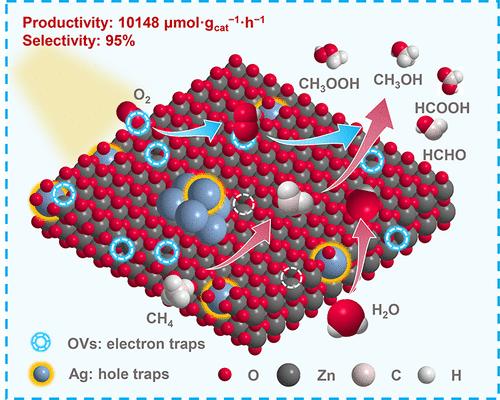非常规载流子转移使氧空位直接还原O2以实现CH4的高效光氧化
IF 8.2
2区 材料科学
Q1 MATERIALS SCIENCE, MULTIDISCIPLINARY
引用次数: 0
摘要
以氧(O2)为氧化剂,光催化氧化甲烷(CH4)制出高附加值的液态氧合物是一个很有前途的方法。除了CH4的活化外,O2选择性还原成氢过氧(·OOH)也是决定整个反应效率和选择性的关键因素。在热催化中,催化剂表面的氧空位(OVs)与O2之间的强相互作用被广泛采用作为增强O2活化的手段。然而,这种现象的报道仅限于光催化;这是由于O2的还原依赖于它与光生电子(e -)的反应。对于大多数光催化剂来说,e -向金属共催化剂的转移导致了e -与ov的空间分离。因此,OVs和O2之间的内在亲和力没有被充分利用。在这项研究中,我们发现在高温下对zif -8衍生的ZnO进行H2处理导致在表面形成一个富含ov的非晶层。引入Ag助催化剂后,制备的Agx-OVs/ZnO表现出非常规的载流子转移方向,即光生成的e -和空穴(h+)分别转移到OVs和Ag上。因此,优先的O2吸附和活化位点可以在OVs上空间组合在一起,从而驱动O2的还原,实现高效定向生成·OOH。同时,h+转移到Ag位点削弱了其氧化能力,在保证CH4活化的同时避免了过度氧化。优化后的富缺陷Ag0.5-OVs/ZnO-z光催化剂的液氧产率为10148 μmol gcat-1 h-1,选择性为95%,TOF为2.4 × 106 μmol gcat-1 h-1。这项工作为通过操纵载体转移方向设计光催化CH4氧化催化剂提供了新的思路。本文章由计算机程序翻译,如有差异,请以英文原文为准。

Unconventional Carrier Transfer Enabled Direct O2 Reduction by Oxygen Vacancies for Efficient Photooxidation of CH4
Photocatalytic oxidation of methane (CH4) to high value-added liquid oxygenates with oxygen (O2) as an oxidant has long been a promising process. In addition to the activation of CH4, the selective reduction of O2 to hydroperoxyl (·OOH) is also a crucial factor in determining the efficiency and selectivity of the overall reaction. In thermal catalysis, strong interactions between oxygen vacancies (OVs) on the catalyst surface and O2 are widely adopted as a means of enhancing O2 activation. However, reports of this phenomenon are limited in photocatalysis; this is attributable to the fact that the reduction of O2 is dependent upon its reaction with photogenerated electrons (e–). For the majority of photocatalysts, the transfer of e– to metal cocatalysts results in the spatial separation of e– from OVs. Therefore, the intrinsic affinity between OVs and O2 is not fully exploited. In this study, we discovered that H2 treatment at elevated temperatures on ZIF-8-derived ZnO led to the formation of an OV-enriched amorphous layer on the surface. After the introduction of the Ag cocatalyst, the as-prepared Agx-OVs/ZnO exhibited an unconventional carrier transfer direction, whereby photogenerated e– and holes (h+) are transferred to OVs and Ag, respectively. As a result, the preferential O2 adsorption and activation sites can be spatially combined together on the OVs and thus drive the reduction of O2 to realize efficient and directed generation of ·OOH. In parallel, the transfer of h+ to the Ag sites weakens its oxidation capability and avoids overoxidation while ensuring CH4 activation. The optimized defect-rich Ag0.5-OVs/ZnO-z photocatalyst reaches a high liquid oxygenate yield of 10148 μmol gcat–1 h–1 with 95% selectivity and a high TOF of 2.4 × 106 μmol gAg–1 h–1. This work sheds new light on the design of photocatalytic CH4 oxidation catalysts via manipulation of carrier transfer direction.
求助全文
通过发布文献求助,成功后即可免费获取论文全文。
去求助
来源期刊

ACS Applied Materials & Interfaces
工程技术-材料科学:综合
CiteScore
16.00
自引率
6.30%
发文量
4978
审稿时长
1.8 months
期刊介绍:
ACS Applied Materials & Interfaces is a leading interdisciplinary journal that brings together chemists, engineers, physicists, and biologists to explore the development and utilization of newly-discovered materials and interfacial processes for specific applications. Our journal has experienced remarkable growth since its establishment in 2009, both in terms of the number of articles published and the impact of the research showcased. We are proud to foster a truly global community, with the majority of published articles originating from outside the United States, reflecting the rapid growth of applied research worldwide.
 求助内容:
求助内容: 应助结果提醒方式:
应助结果提醒方式:


